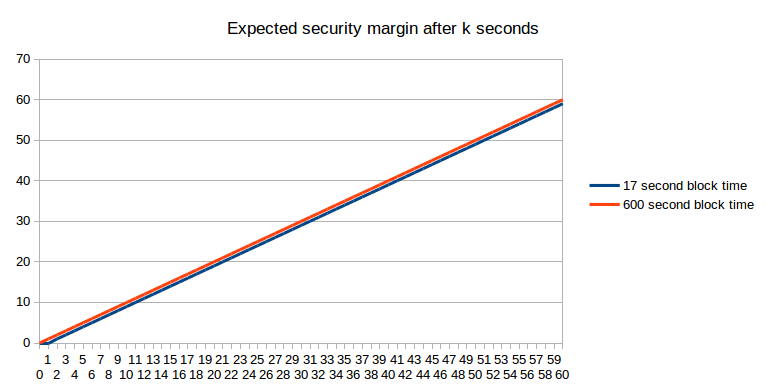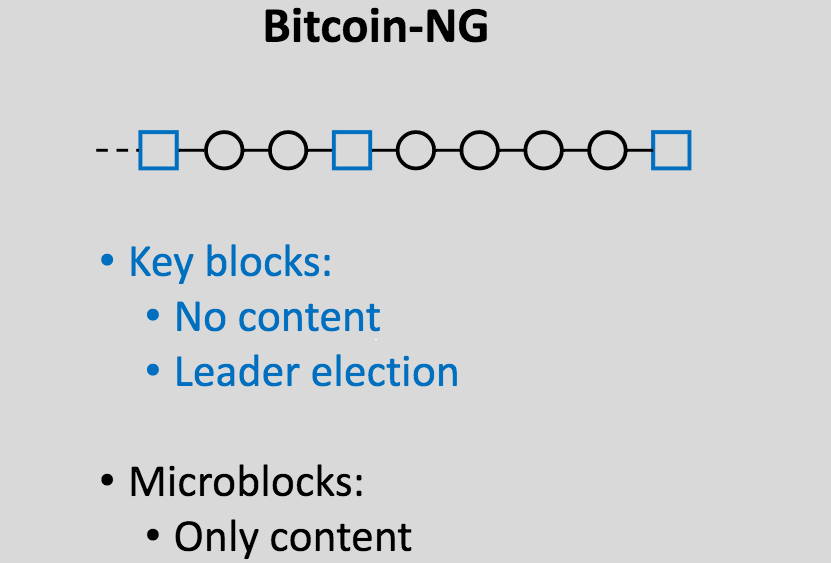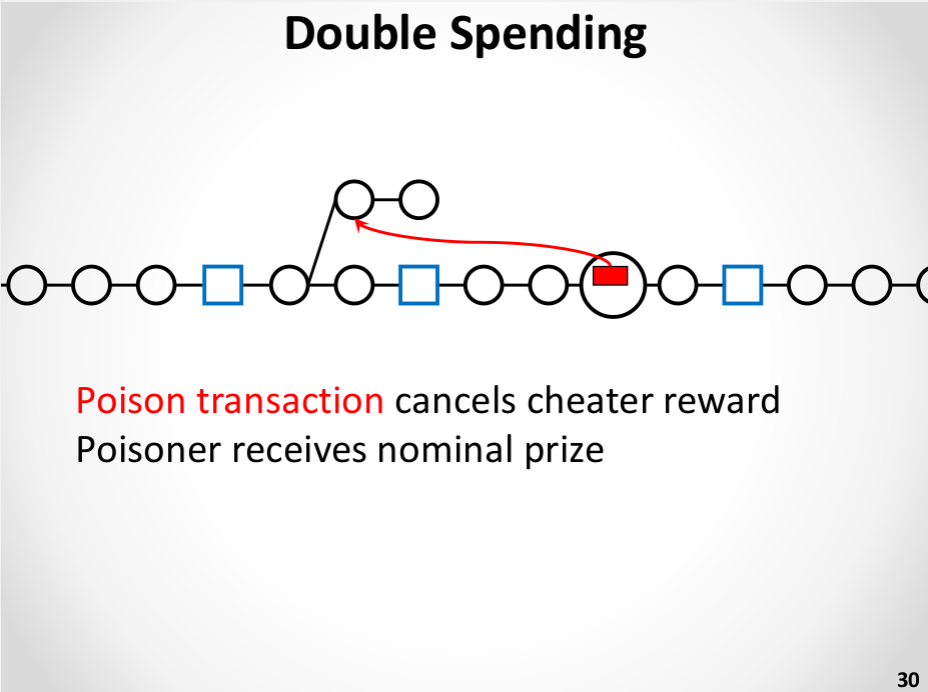One of many largest sources of confusion within the query of blockchain safety is the exact impact of the block time. If one blockchain has a block time of 10 minutes, and the opposite has an estimated block time of 17 seconds, then what precisely does that imply? What’s the equal of six confirmations on the 10-minute blockchain on the 17-second blockchain? Is blockchain safety merely a matter of time, is it a matter of blocks, or a mixture of each? What safety properties do extra advanced schemes have?
Notice: this text won’t go into depth on the centralization dangers related to quick block occasions; centralization dangers are a serious concern, and are the first motive to not push block occasions all the way in which right down to 1 second regardless of the advantages, and are mentioned at far more size in this previous article; the aim of this text is to clarify why quick block occasions are fascinating in any respect.
The reply the truth is relies upon crucially on the safety mannequin that we’re utilizing; that’s, what are the properties of the attackers that we’re assuming exist? Are they rational, byzantine, economically bounded, computationally bounded, in a position to bribe strange customers or not? Basically, blockchain safety evaluation makes use of certainly one of three totally different safety fashions:
- Regular-case mannequin: there aren’t any attackers. Both everyone seems to be altruistic, or everyone seems to be rational however acts in an uncoordinated means.
- Byzantine fault tolerance mannequin: a sure proportion of all miners are attackers, and the remainder are sincere altruistic folks.
- Financial mannequin: there’s an attacker with a funds of $X which the attacker can spend to both buy their very own {hardware} or bribe different customers, who’re rational.
Actuality is a combination between the three; nevertheless, we will glean many insights by inspecting the three fashions individually and seeing what occurs in every one.
The Regular Case
Allow us to first begin off by wanting on the regular case. Right here, there aren’t any attackers, and all miners merely wish to fortunately sing collectively and get alongside whereas they proceed progressively extending the blockchain. Now, the query we wish to reply is that this: suppose that somebody despatched a transaction, and ok seconds have elapsed. Then, this individual sends a double-spend transaction attempting to revert their authentic transaction (eg. if the unique transaction despatched $50000 to you, the double-spend spends the identical $50000 however directs it into one other account owned by the attacker). What’s the chance that the unique transaction, and never the double-spend, will find yourself within the remaining blockchain?
Notice that, if all miners are genuinely good and altruistic, they won’t settle for any double-spends that come after the unique transaction, and so the chance ought to method 100% after a number of seconds, no matter block time. One technique to chill out the mannequin is to imagine a small proportion of attackers; if the block time is extraordinarily lengthy, then the chance {that a} transaction can be finalized can by no means exceed 1-x, the place x is the share of attackers, earlier than a block will get created. We are going to cowl this within the subsequent part. One other method is to chill out the altruism assumption and as a substitute focus on uncoordinated rationality; on this case, an attacker attempting to double-spend can bribe miners to incorporate their double-spend transaction by putting the next price on it (that is basically Peter Todd’s replace-by-fee). Therefore, as soon as the attacker broadcasts their double-spend, it will likely be accepted in any newly created block, apart from blocks in chains the place the unique transaction was already included.
We will incorporate this assumption into our query by making it barely extra advanced: what’s the chance that the unique transaction has been positioned in a block that may find yourself as a part of the ultimate blockchain? Step one to attending to that state is getting included in a block within the first place. The chance that it will happen after ok seconds is fairly properly established:
Sadly, moving into one block isn’t the tip of the story. Maybe, when that block is created, one other block is created on the similar time (or, extra exactly, inside community latency); at that time, we will assume as a primary approximation that it’s a 50:50 likelihood which of these two blocks the subsequent block can be constructed on, and that block will finally “win” – or, maybe, two blocks can be created as soon as once more on the similar time, and the competition will repeat itself. Even after two blocks have been created, it is doable that some miner has not but seen each blocks, and that miner will get fortunate and created three blocks one after the opposite. The chances are doubtless mathematically intractable, so we are going to simply take the lazy shortcut and simulate them:

The outcomes may be understood mathematically. At 17 seconds (ie. 100% of the block time), the sooner blockchain offers a chance of ~0.56: barely smaller than the matheatically predicted 1-1/e ~= 0.632 due to the potential of two blocks being created on the similar time and one being discarded; at 600 seconds, the slower blockchain offers a chance of 0.629, solely barely smaller than the anticipated 0.632 as a result of with 10-minute blocks the chance of two blocks being created on the similar time could be very small. Therefore, we will see that sooner blockchains do have a slight drawback due to the upper affect of community latency, but when we do a good comparability (ie. ready a specific variety of seconds), the chance of non-reversion of the unique transaction on the sooner blockchain is far larger.
Attackers
Now, let’s add some attackers into the image. Suppose that portion X of the community is taken up by attackers, and the remaining 1-X is made up of both altruistic or egocentric however uncoordinated (barring egocentric mining issues, as much as X it really doesn’t matter which) miners. The best mathematical mannequin to make use of to approximate that is the weighted random stroll. We begin off assuming {that a} transaction has been confirmed for ok blocks, and that the attacker, who can also be a miner, now tries to begin a fork of the blockchain. From there, we symbolize the state of affairs with a rating of ok, that means that the attacker’s blockchain is ok blocks behind the unique chain, and at each step make the statement that there’s a chance of X that the attacker will make the subsequent block, altering the rating to k-1 and a chance of 1-X that sincere miners mining on the unique chain will make the subsequent block, altering the rating to ok+1. If we get to ok = 0, that implies that the unique chain and the attacker’s chain have the identical size, and so the attacker wins.
Mathematically, we all know that the chance of the attacker profitable such a recreation (assuming x < 0.5 as in any other case the attacker can overwhelm the community it doesn’t matter what the blockchain parameters are) is:

We will mix this with a chance estimate for ok (utilizing the Poisson distribution) and get the online chance of the attacker profitable after a given variety of seconds:

Notice that for quick block occasions, we do need to make an adjustment as a result of the stale charges are greater, and we do that within the above graph: we set X = 0.25 for the 600s blockchain and X = 0.28 for the 17s blockchain. Therefore, the sooner blockchain does enable the chance of non-reversion to achieve 1 a lot sooner. One different argument that could be raised is that the decreased price of attacking a blockchain for a brief period of time over a protracted period of time implies that assaults towards quick blockchains might occur extra ceaselessly; nevertheless, this solely barely mitigates quick blockchains’ benefit. For instance, if assaults occur 10x extra usually, then because of this we must be comfy with, for instance, a 99.99% chance of non-reversion, if earlier than we have been comfy with a 99.9% chance of non-reversion. Nonetheless, the chance of non-reversion approaches 1 exponentially, and so solely a small variety of additional confirmations (to be exact, round two to 5) on the sooner chain is required to bridge the hole; therefore, the 17-second blockchain will doubtless require ten confirmations (~three minutes) to realize the same diploma of safety below this probabilistic mannequin to 6 confirmations (~one hour) on the ten-minute blockchain.
Economically Bounded Attackers
We will additionally method the topic of attackers from the opposite aspect: the attacker has $X to spend, and might spend it on bribes, near-infinite instantaneous hashpower, or anything. How excessive is the requisite X to revert a transaction after ok seconds? Primarily, this query is equal to “how a lot financial expenditure does it take to revert the variety of blocks that may have been produced on prime of a transaction after ok seconds”. From an expected-value standpoint, the reply is straightforward (assuming a block reward of 1 coin per second in each circumstances):

If we bear in mind stale charges, the image really turns barely in favor of the longer block time:

However “what’s the anticipated financial safety margin after ok seconds” (utilizing “anticipated” right here within the formal probability-theoretic sense the place it roughly means “common”) is definitely not the query that most individuals are asking. As a substitute, the issue that issues strange customers is arguably certainly one of them desirous to get “sufficient” safety margin, and desirous to get there as shortly as doable. For instance, if I’m utilizing the blockchain to buy a $2 espresso, then a safety margin of $0.03 (the present bitcoin transaction price, which an attacker would want to outbid in a replace-by-fee mannequin) is clearly not sufficient, however a safety margin of $5 is clearly sufficient (ie. only a few assaults would occur that spend $5 to steal $2 from you), and a safety margin of $50000 isn’t significantly better. Now, allow us to take this strict binary sufficient/not-enough mannequin and apply it to a case the place the fee is so small that one block reward on the sooner blockchain is bigger than the price. The chance that we’ll have “sufficient” safety margin after a given variety of seconds is strictly equal to a chart that we already noticed earlier:

Now, allow us to suppose that the specified safety margin is price between 4 and 5 occasions the smaller block reward; right here, on the smaller chain we have to compute the chance that after ok seconds not less than 5 blocks can have been produced, which we will do by way of the Poisson distribution:

Now, allow us to suppose that the specified safety margin is price as a lot because the bigger block reward:

Right here, we will see that quick blocks now not present an unambiguous profit; within the brief time period they really harm your possibilities of getting extra safety, although that’s compensated by higher efficiency in the long run. Nonetheless, what they do present is extra predictability; somewhat than a protracted exponential curve of doable occasions at which you’re going to get sufficient safety, with quick blocks it’s just about sure that you’re going to get what you want inside 7 to 14 minutes. Now, allow us to maintain rising the specified safety margin additional:


As you may see, as the specified safety margin will get very excessive, it now not actually issues that a lot. Nonetheless, at these ranges, it’s important to wait a day for the specified safety margin to be achieved in any case, and that could be a size of time that the majority blockchain customers in observe don’t find yourself ready; therefore, we will conclude that both (i) the financial mannequin of safety isn’t the one that’s dominant, not less than on the margin, or (ii) most transactions are small to medium sized, and so really do profit from the larger predictability of small block occasions.
We must also point out the potential of reverts on account of unexpected exigencies; for instance, a blockchain fork. Nonetheless, in these circumstances too, the “six confirmations” utilized by most websites isn’t sufficient, and ready a day is required in an effort to be really protected.
The conclusion of all that is easy: sooner block occasions are good as a result of they supply extra granularity of knowledge. Within the BFT safety fashions, this granularity ensures that the system can extra shortly converge on the “appropriate” fork over an incorrect fork, and in an financial safety mannequin because of this the system can extra shortly give notification to customers of when an appropriate safety margin has been reached.
After all, sooner block occasions do have their prices; stale charges are maybe the biggest, and it’s after all essential to steadiness the 2 – a steadiness which would require ongoing analysis, and maybe even novel approaches to fixing centralization issues arising from networking lag. Some builders might have the opinion that the consumer comfort offered by sooner block occasions isn’t well worth the dangers to centralization, and the purpose at which this turns into an issue differs for various folks, and may be pushed nearer towards zero by introducing novel mechanisms. What I hope to disprove right here is just the declare, repeated by some, that quick block occasions present no profit in any way as a result of if every block is fifty occasions sooner then every block is fifty occasions much less safe.
Appendix: Eyal and Sirer’s Bitcoin NG
A current fascinating proposal offered on the Scaling Bitcoin convention in Montreal is the thought of splitting blocks into two varieties: (i) rare (eg. 10 minute heartbeat) “key blocks” which choose the “chief” that creates the subsequent blocks that include transactions, and (ii) frequent (eg. 10 second heartbeat) “microblocks” which include transactions:

The idea is that we will get very quick blocks with out the centralization risks by basically electing a dictator solely as soon as each (on common) ten minutes, for these ten minutes, and permitting the dictator to provide blocks in a short time. A dictator “ought to” produce blocks as soon as each ten seconds, and within the case that the dictator makes an attempt to double-spend their very own blocks and create an extended new set of microblocks, a Slasher-style algorithm is used the place the dictator may be punished in the event that they get caught:

That is actually an enchancment over plain previous ten-minute blocks. Nonetheless, it isn’t practically as efficient as merely having common blocks come as soon as each ten seconds. The reasoning is straightforward. Beneath the economically-bounded attacker mannequin, it really does provide the identical possibilities of assurances because the ten-second mannequin. Beneath the BFT mannequin, nevertheless, it fails: if an attacker has 10% hashpower then the chance {that a} transaction can be remaining can not exceed 90% till not less than two key blocks are created. In actuality, which may be modeled as a hybrid between the financial and BFT eventualities, we will say that despite the fact that 10-second microblocks and 10-second actual blocks have the identical safety margin, within the 10-second microblock case “collusion” is less complicated as throughout the 10-minute margin just one celebration must take part within the assault. One doable enchancment to the algorithm could also be to have microblock creators rotate throughout every inter-key-block section, taking from the creators of the final 100 key blocks, however taking this method to its logical conclusion will doubtless result in reinventing full-on Slasher-style proof of stake, albeit with a proof of labor issuance mannequin connected.
Nonetheless, the final method of segregating chief election and transaction processing does have one main profit: it reduces centralization dangers on account of gradual block propagation (as key block propagation time doesn’t rely on the dimensions of the content-carrying block), and thus considerably will increase the utmost protected transaction throughput (even past the margin offered by Ethereum-esque uncle mechanisms), and because of this additional analysis on such schemes ought to actually be achieved.
